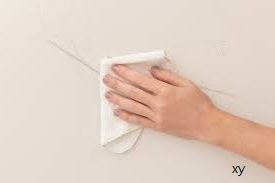
When we think about most hard surfaces within our homes, walls make up a large percentage of our space, separating rooms and providing shelter to keep us dry and safe. Even though walls are vertical, they still become dirty, scuffed, and collect dust over time, making it important to periodically clean the walls in our homes to prolong their life and keep them looking their best. Areas near doors, light switches, skirting, and furniture suffer the most wear and tear and these are some of the areas in which we need to clean as regularly as we do our floors.
With a few simple products and techniques, you can easily maintain the walls paint and keep them looking fresher for longer, reducing the need to redecorate frequently.
How often to clean walls
Along with the other regular chores we carry out within our home week to week, dusting and removing cobwebs from walls and ceilings should be carried out at least monthly – twice a month is even better. Scuffs and dirty marks around doorknobs and light switches weekly. Large splatters or scribbles with colouring pencils/crayons should be cleaned immediately for best results.
Using an antibacterial wipe or cleaner is a great way to kill germs and stop their spread throughout your home
Before you begin
Dusting can be done to every type of paint finish; however, the paint type and finish determine how best to clean it to maintain the paint quality. Determine your kind of paint and check the lists below for pre-cleaning tips..
Types of interior wall paint
Oil-based paint: often used in rooms such as the bathroom or kitchen as they are usually high moisture areas and oil-based paint is more durable than latex/water-based paints.
Latex/water-based paint: Most popular interior wall paint, more resistant to cracking and chipping than oil-based paints but not as receptive to water-based cleaning.
Types of interior paint finishes
Matte: A chalky feeling finish with no shine to the surface. Doesn’t clean well, do not use harsh chemicals or excessive pressure when cleaning.
Satin or Eggshell: More reflective paint which bounces the light round the room, more durable and suitable for high traffic areas with lots of use like bedrooms or hallways. Do not use abrasive cleansers, limiting amount of moisture when cleaning.
Semi-gloss: Reflects the light more than satin or eggshell, with a noticeable sheen. A great choice for kitchens, bathrooms, skirting and trims. Holds up well to moisture but not harsh chemicals.
High gloss: A very robust shiny paint finish which is the most durable of all the paint finishes. An excellent choice for furniture, cabinets, and trim. Cleans easily with a detergent or degreaser.
What You'll Need
Equipment / Tools
C) Vaccum or Duster
E) Step stool or ladder
Materials
C) Distilled white vinegar
D) Baking Soda
E) Isopropyl rubbing alcohol

Instructions
Tackling Heavily Soiled Areas
When cleaning light switches and plug sockets, ensure the electricity is turned off and do not allow these areas to get excessively wet. If scuffs and heavy marks don’t come off easily, dip your dampened cloth into some baking soda and lightly rub the affected area.
The gentle abrasion from the baking soda should help remove the marks. A bit of rubbing alcohol on a sponge works well to remove soil from painted areas around doorknobs and trim work.
How to Clean Oil-Based Painted Walls
Remove Dust – using a vacuum cleaner, start at the top of the wall, making your way to the bottom, be sure to do the skirting and architrave if you have any. Be sure to use steps or a ladder when reaching the high spots.
Mix cleaning solution – Add one teaspoon dishwashing liquid and ½ teaspoon distilled white vinegar per ¼ bucket of warm water. Fill a second bucket with clean water for rinsing.
Wipe and rinse – Using your microfibre cloth or sponge, dip into the cleaning solution and wring out well. Wipe down the walls starting at the top to avoid the dirty water dripping on areas you’ve already cleaned. Follow up with a sponge in the clean water to rinse the walls.
Tackle Tough Stains
A melamine sponge (magic eraser) can help to remove the tough stains on semi-gloss and high gloss finishes. Ensure you avoid rubbing to heavily or you may remove the sheen from the paint finish.
Tips to Keep Walls Clean Longer
To keep your walls cleaner for longer, there are a few things you can do:
Avoid smoke in the house, from cigarettes, cooking or burning candles or incense. The smoke can coat walls getting them dirty quickly
If messy handprints or sticky marks appear, try to spot clean them immediately in-between the more thorough cleans to prolong the appearance of clean walls longer.
Conclusion
Although the above guidance when followed will keep your walls to a high standard for a long time, there will become a point where painting the wall will be required. This will give your walls a facelift back to the original standard and perhaps something you would want to consider doing every couple of years as a guide. This would be dependant on various factors such as whether you have children or pets living with you which can sometimes be prone to being a little messy at times!

What can you do if you have a question that’s not listed here?
If you have a question about our products that you can’t find an answer to, you can always contact us at sales@hcinnovations.co.uk or call us on 01738 629839. Our friendly team can answer any questions you may have, and they will get back to you as soon as possible.